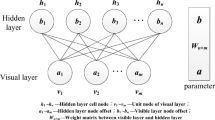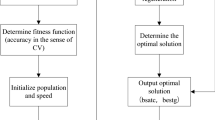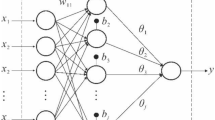Abstract
In order to establish an effective coal mine floor water inrush prediction model, a neural network prediction method of water inrush based on an improved SMOTE algorithm expanding a small sample dataset and optimizing a deep confidence network was proposed. ISMOTE is used to enlarge the coal mine’s measured data collection, while PCA is used to minimize the data’s dimension. DBN is used to extract water inrush data features and estimate water inrush danger in coal mines. As the water inrush samples are small, they cannot provide enough information about the occurrence of water inrush accidents, which affects the DBN analysis of water inrush accidents, reduces the prediction accuracy, and causes safety hazards when mining in the coal mines. An improved SMOTE algorithm is used to expand the dataset. The DBN network is used to extract the secondary features of the nonlinear data after processing. Finally, a prediction model is established to predict coal mine water inrush. The superiority of this method is verified by the comparison between the actual condition and the prediction of the measured working face in a typical mining area in North China. The prediction accuracy of coal mine water inrush obtained by the model proposed in this paper is 94%, while the prediction accuracy of traditional BP algorithm is 70%, and the prediction accuracy of SAE algorithm is 91%, better than the rates of other methods. The findings of this study can be used to better predict and analyze coal mine water inrush accidents, improve the accuracy of water inrush accident prediction, and encourage the use of deep learning in coal mine floor water inrush prediction, all of which have theoretical and practical implications.







Similar content being viewed by others
References
Cao QK, Zhao F (2011) Prediction of water inrush from coal floor based on genetic-support vector regression. J Coal 36(12):2097–2101
Chen K, Zhou XC, Fang JQ et al (2017) Fault feature extraction and diagnosis of gearbox based on EE-MD and deep briefs network. Int J Rotating Mach 40(1):119. https://doi.org/10.1155/2017/9602650
Du CL, Zhang XY, Fenglian Li (2014) Application of improved CART algorithm in prediction of water inrush from coal seam floor. Ind Mine Autom 40(12):52–56. https://doi.org/10.13272/j.issn.1671-251x.2014.12.014
Duan H (2012) Study on method of water inrush risk assessment of mining above confined aquifer. China University of Mining and Technology, Xuzhou (in Chinese)
Gao Q, Ma Y (2016) Research and application of the level of the deep belief network. Sci Technol Eng 16(23):234–262
Hao H, Jingming W (2015) Research on water inrush from the blind fault of coal floor by physical experiment. J North China Inst Sci Technol (nat Sci) 12(1):11–16
Li P (2014) The application of forecasting model based on PCA—ELM in coal mine water burst prediction. China University of Mining and Technology, Xuzhou (in Chinese)
Li FJ, Zheng J (2010) The prediction and forecast of coal floor water-inrush based on GIS: a case study on the I-1 mining district in the 5# coal mine in Pingdingshan area. In: International conference on environmental science and information application technology. IEEE 2010, pp 663–666. https://doi.org/10.1109/ESIAT.2010.5568339
Liu Z, Jin D, Liu Q (2009) Prediction of water inrush from seam floor based on binomial logistic regression model and CART tree. Coal Geol Explor 37(1):56–61
Liu Z, Jin D, Liu Q (2011) Prediction of water inrush through coal floors based on data mining classification technique. Procedia Earth Planet Sci 3:166–174. https://doi.org/10.1016/j.proeps.2011.09.079
Ma D, Duan H, Cai X, Li Z, Li Q, Zhang Q (2018) A global optimization-based method for the prediction of water inrush hazard from mining floor. Water 10(11):1618. https://doi.org/10.3390/w10111618
Minggao Q, Xiexing M, Liangjie Li (1995) Mechanism of mail of the fracture behaviours floor in longwall mining. Chin J Geotech Eng 17(6):56–61
Qiao Y (2010) Application research of genetic algorithm and artificial neural networks in the prediction of mine water gushing-out. Xi’an University of Architecture and Technology, Xi’an (in Chinese)
Shi L (2012) Analysis of water inrush coefficient and its applicability. J Shandong Univ Sci Technol 31(6):6–9. https://doi.org/10.16452/j.cnki.sdkjzk.2012.06.002
Shi LQ, Han J (2004) Floor water inrush mechanism and prediction. China University of Mining and Technology Press, Xuzhou
Shi L, Han J (2005) Theory and practice of dividing coal mining area floor into four-zone. J China Univ Min Technol 42(1):16–23
Shi L, Tan X, Wang J et al (2015) Risk assessment of water inrush based on PCA-Fuzzy-PSO-SVC. J China Coal Soc 40(1):167–171. https://doi.org/10.13225/j.cnki.jccs.2014.0370
Shi L, Gao W, Han J et al (2017) A nonlinear risk evaluation method for water inrush through the seam floor. Mine Water Environ 34(4):1–9. https://doi.org/10.1007/s10230-017-0449-1
Weitao L, Shanghui L, Shiliang L et al (2015) Principal component logistic regression analysis in application of water outbursts from coal seam floor. J Liaoning Tech Univ 34(8):905–909
Wu K, Liu XZ, Zhang XX, Miao Y (2020) Feature extraction of hot strip rolling data based on PCA-DBN. Metall Ind Autom 44(3):21–25
Zhang JC, Liu T (1990) On depth of fissured zone in seam floor resulted from coal extraction and its distribution characteristics. J China Coal Soc 2:35–38
Zhao Z, Hu M (2014) Multi-level forecasting model of coal mine water inrush based on self-adaptive evolutionary extreme learning machine. Appl Math Inf Sci Lett 2(3):103–110. https://doi.org/10.12785/amisl/020305
Zhao Z, Li P, Xu X (2013) Forecasting model of coal mine water inrush based on extreme learning machine. Appl Math Inf Sci 7(3):1243–1250. https://doi.org/10.12785/amis/070349
Zhao D, Wu Q, Cui F, Xu H, Zeng Y, Cao Y, Du Y (2018) Using random forest for the risk assessment of coal-floor water inrush in Panjiayao Coal Mine, northern China. Hydrogeol J 26(7):2327–2340. https://doi.org/10.1007/s10040-018-1767-5
Zhigang Y, Haibo B, Hairong Z (2008) A novel SVM model for the analysis and prediction of water inrush from coal mine. J Chin Secur Sci 18(7):166–170. https://doi.org/10.1016/S1005-8885(08)60096-5
Funding
The funding was provided by Key Technologies Research and Development Program (Grant No. 2017YFF0205500).
Author information
Authors and Affiliations
Contributions
All authors contributed to the study conception and design. Material preparation, data collection, and analysis were performed by TS, SK, TX, and ZY. The first draft of the manuscript was written by ZY, and all authors commented on previous versions of the manuscript. All authors read and approved the final manuscript.
Corresponding author
Ethics declarations
Ethical approval
I testify on behalf of all co-authors that our article submitted to Natural Hazards. All authors: (1) This material has not been published in whole elsewhere; (2) the manuscript is not currently being considered for publication in another journal; and (3) all authors have been personally and actively involved in substantive work leading to the manuscript, and will hold themselves jointly and individually responsible for its content.
Additional information
Publisher's Note
Springer Nature remains neutral with regard to jurisdictional claims in published maps and institutional affiliations.
Rights and permissions
Springer Nature or its licensor (e.g. a society or other partner) holds exclusive rights to this article under a publishing agreement with the author(s) or other rightsholder(s); author self-archiving of the accepted manuscript version of this article is solely governed by the terms of such publishing agreement and applicable law.
About this article
Cite this article
Ye, Z., Shoufeng, T., Ke, S. et al. An evaluation of the mine water inrush based on the deep learning of ISMOTE. Nat Hazards 117, 1475–1491 (2023). https://doi.org/10.1007/s11069-023-05912-3
Received:
Accepted:
Published:
Issue Date:
DOI: https://doi.org/10.1007/s11069-023-05912-3




